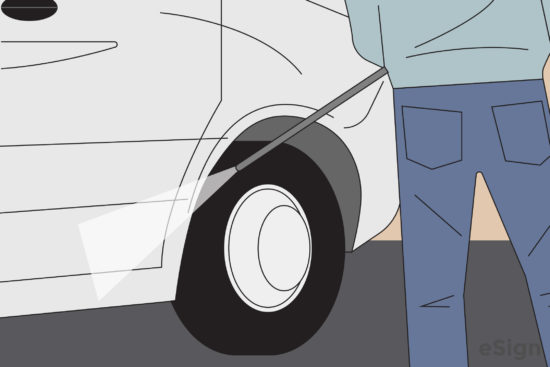Commonly Used For:
- Class A, B, & C motorhomes
- Travel trailers
- Fifth wheels
- Toy haulers
- Pop-ups
- Truck campers
How to Sell an RV
Step 1 – Clean and Inspect
The RV should be properly cleaned and inspected to make it more attractive to buyers. It is worthwhile to check for mold or other issues and test the lights, appliances, generator, and other components.
Download the RV Inspection Checklist for a comprehensive list of items to check prior to listing your RV for sale. Take photos of the RV when it is cleaned and ready to be advertised.
Step 2 – Organize Paperwork
To ensure a smooth transaction, the seller should gather the vehicle’s title and all information needed to complete the RV bill of sale. The bill of sale can be mostly completed with the vehicle and owner’s information, but shouldn’t be signed.
The owner may want to gather service records and any documentation that was provided when the RV was first purchased in case the buyer is interested.
What If the RV Has a Lien?
The seller should be transparent with prospective buyers about whether the RV has a lien. If this is the case, the transfer process is more involved than simply signing over the title.
The lien must be paid in full for the financial institution to release the title. The financier should be informed of the situation.
Step 3 – Advertise
The seller can advertise their RV by putting a “for sale” sign on it and marketing it on social media, online marketing platforms, and newspaper classifieds.
Step 4 – Show and Negotiate
After the RV is properly listed, interested buyers will start contacting the seller to set up viewings. During showings, buyers may wish to test certain functionalities of the vehicle or even take it for a test drive.
If a buyer is interested, the parties can negotiate a price and other terms. Once they have agreed on the terms and conditions, they can finalize the transaction.
Step 5 -Finalize the Sale
The bill of sale, which was mostly filled out ahead of time, can now be completed with the buyer’s contact information and the sale price. The parties shouldn’t sign the bill of sale until the buyer has paid the seller in full.
Some jurisdictions may require notarization, in which case, the parties should only sign in the presence of a notary public. Alternatively, the document can be uploaded to eSign and signed and notarized online.
Sample
Download: PDF, Word (.docx), OpenDocument
RV BILL OF SALE
In consideration of the sum of $[AMOUNT] paid by [BUYER NAME] with a mailing address of [BUYER ADDRESS] (the “Buyer”) to [SELLER NAME] with a mailing address of [SELLER ADDRESS] (the “Seller), the Seller hereby conveys the following described recreational vehicle:
Make: [MAKE] Model: [MODEL] Year: [YYYY] Length (ft): [#] Slides: [#]
Fuel Type: [FUEL TYPE] Ext. Color: [COLOR] VIN: [#] Odometer (if applicable): [#]
Other: [OTHER INFO]
Type: ☐ Motorhome ☐ Travel Trailer ☐ 5th Wheel ☐ Pop-Up ☐ Toy Hauler ☐ Truck Camper
Hereinafter known as the “Recreational Vehicle.”
The Recreation Vehicle is to be sold free and clear of any liens, encumbrances, or mortgages. Seller certifies that they are the legal and true owner of the Recreational Vehicle and are selling it in “as-is” condition.
IN WITNESS WHEREOF, the Buyer and Seller agree to the terms of this Bill of Sale.
Buyer’s Signature: ____________________ Date: [SIGNING DATE]
Printed Name: [BUYER NAME]
Seller’s Signature: ____________________ Date: [SIGNING DATE]
Printed Name: [SELLER NAME]
CERTIFICATE OF ACKNOWLEDGMENT
State of [NOTARY: STATE]
County of [NOTARY: COUNTY]
On [NOTARY: DATE], before me, [NOTARY: NOTARY NAME] personally appeared [BUYER NAME] and [SELLER NAME], proved to me on the basis of satisfactory evidence to be the persons whose names are subscribed to the within instrument and acknowledged to me that they executed the same in their authorized capacities and that by their signatures on the instrument, the persons or the entity upon behalf of which the persons acted, executed the instrument.
WITNESS my hand and official seal,
Notary Signature: ____________________ Date: [NOTARY: SIGNING DATE]
Printed Name: [NOTARY: NOTARY NAME]
My Commission Expires: [NOTARY: EXPIRATION]
(seal)






